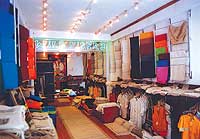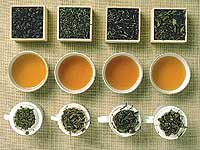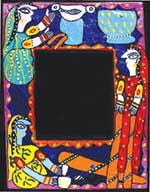In the not-so-distant past, Nepalis were hardwired into thinking that the "Made in Nepal" tag didn't make the grade. Today, we know better. With some exceptions, and despite everything we have done to tarnish the brand name, 'Nepal' still evokes things exotic and beautiful, and increasingly, quality and style.
Luckily, we have more to fall back on than just our natural bounty. It is matched by a culture rich in tradition and skill. Carpets, metallurgy, jewelry, woodcrafts and weaving have been passed on through the ages, finding an increasingly wider audience of appreciation. The 'Made in Nepal' label may be ubiquitous on shirts and loose pants in Wall Marts, but it is also being found increasingly in the best galleries and shops in Europe, North America, Australia and Japan. Unfortunately, export trade winds are capricious. A combination of the Maoist insurgency, SARS and various wars on terror has impacted consumer confidence. Advertising budgets were slashed and we lost out even on the old word-of-mouth. The domestic market is stagnating because of the fall in tourism. After getting this far, Nepali exporters are left to fend for themselves. We are doing our bit here to showcase a few Made in Nepals that we can take pride in.
 Silver Jewelry
Silver Jewelry
The Newari and Tibetan styles of jewelry from Kathmandu adorn the most discerning necks around the world. Silver jewelry can be found throughout Thamel, Patan and Bhaktapur-the last two being traditional silversmith centres over centuries. What used to be exclusively the preserve of the Shakya and Bajracharya enterprise, has had to admit Bishwakarmas (or blacksmiths) too or face the possibility of dying out. Yak and Yeti Enterprises have been collecting and selling unique jewelry since 1984. What they have is markedly different from the mass produced ware out on the streets. For one thing, the finish is impeccable. Closer inspection reveals ancient Nepali designs have been given modern interpretations-elegantly fluid turquoise and silver bracelets, coral hair clips, drops and necklaces. Everything in the store is sourced from silversmith families in the Valley.
 Metalworks
Metalworks
Every copper statue of Avalokiteshvara or Saraswati, and every brass pana (lamp) that you see today has hundreds of years of tradition behind it. The craftspeople of Patan and Bhaktapur have preserved the art of making statues, metal pots, lamps and other items, be they sacred or profane, over hundreds of years by passing the techniques on from one generation to the next. Today, many of the younger ones have forsaken these traditions and opted for more modern jobs. But lately there is a distinct feel of renaissance in the air. Tamrakar Antiques in Baber Mahal Revisited has a wonderful collection of antique brass items. The items are snapped up by art enthusiasts. Dev Tamrakar remembers his favourite customer fondly: Michael S Friedman bought around 1,500 pieces from his collection and then wrote a book about the art of casting vessels, decanters and bowls.
The main workshops of Fabulous Handicraft Centre are at Okubahal, the old metal working area of Patan. They turns out the most exquisite copper statues (see pic), some which take upto three years to complete. In the time-honoured fashion, three craftspeople work on each piece, no matter how small-one to model the wax, cover it with clay and finally to pour the molten copper into the clay mould, another to etch details and finally a person to paint the face and body.
 Fabric
Fabric
Who would have thought an innocuous stinging plant could clothe royalty? Nettles have a long history in Europe, where it was made into fine lace, velvet, satin and muslin-fit for the French court-before Marco Polo brought silk back from the Orient. In Nepal today the very same plant has been harvested for fabric made into everything from shirts to tablecloths. Mark Rose came to Nepal in 1993 after he heard about our sisno-the special high yield Himalayan nettle. He soon began manufacturing nettle yarn (see pic, left) under the Wild Fibers label and now has two stores in Thamel, with a third in the pipeline.
The Mandala Boutique, part of Yak and Yeti Enterprises, has an array of silk saris, scarves and shirts, all hand-dyed and painted by skilled local artists. The silk may come from China, but the art and designs are pure Nepali. The shirts and scarves are popular export items with their distinctive designs and beautiful hues. The most coveted is the Mandala sari, which is truly one of a kind. Binita Basnet of Clay Crafts & More is just as adept at fabric painting. She works alone on the five and a half yards that make a sari and the results are breathtaking.
 Pashmina
Pashmina
Two years ago, if you said "70:30" people would think you were talking about basketball scores. Today, everyone knows it is the standard ratio of pashmina to silk. When our shawls became status symbols among the Western elite, it heralded a boom in exports. Today, what has been lost in the exclusivity cachet is more than made up by the volume of exports, even though exports are not what they used to be. Nepal Pashmina has produced and exported quality since 1985, while upscale boutiques like Zaren in Baber Mahal Revisited have designer stoles and shawls embellished with fine embroidery and sequins.
 Thangkas
Thangkas
Few of us know that Kathmandu Valley's Newari paubha painting technique (see pic, left) was the precursor to thangkas. Pau is Newari for coconut leaf parchment and bha is used for anything that is nice or lovely. It's a fitting, if a little understated, description for the jewel toned paintings largely known as the thangka today. Paubhas date back to the 12th century when Malla kings patronised Newar painters. The Newari style was taken to Tibet by Bhrikuti, the daughter of Amshuvarma the Malla king and patron of the arts, who is now immortalised as the Green Tara. Today thangkas and paubhas are widely available. Tibetan thangkas have gained an appreciative audience abroad where they are found in private homes as well as monasteries and art galleries. Nearly 80 percent of the stock in thangkas at Thangka House in Thamel, who have been in the business since 1970, are made in-house by master artistans and their apprentices.
 Carpets
Carpets
Carpet weaving came into its own only with the influx of Tibetan refugees in the 1960s who settled in small weaving communities around Boudha and Jawalakhel. Designs and colour schemes adapted to changing tastes and the international market, and within three decades it was a roaring trade. The bottom may have fallen out of the market, but businesses like Surya Rug House have held onto its reputation as a top exporter of fine hand-knotted carpets. At his showroom in Gyaneswor, managing director Dev Anand Sarawagi happily presents wool and silk mixed rugs with 100 knots per square inch, all ready for shipping. Since 9/11, demand from the US has slowed. Regardless, he continues to layout a wide variety of virgin Tibetan wool handwoven rugs in either vegetable or chemical dyes.
 Tea
Tea
Nepalis love their cuppa. Chia is an integral part of the Nepali experience, which goes back to 1843 when Colonel Gajraj Singh Thapa, the son-in-law of Prime Minister Jung Bahadur Rana, took a tour of Darjeeling and developed a taste for the brew that was grown in the area. He established tea estates in Ilam and Soktim, reasoning that it had the same geographical and climactic essentials as Darjeeling. He wasn't wrong. In fact, it turns out, Ilam may be even better suited. Today over 3,000 hectares in Jhapa, Ilam, Terathum, Dhankuta, and Panchthar grow tea on public and private estates. At Kamal Raj Mainali's Nepal Tea House in New Road there is a rich bouquet of teas: fruit flavours, herbal, green, black and more.
 Handicraft
Handicraft
From cushion covers to clay pots, they all bear the legend 'Made in Nepal'. While most never reach the local retail market, many outlets in Kupondole offer a wide sample of Nepali cottage craft. Dhukuti, the retail outlet of Association for Craft Producers (ACP) has been selling a diverse catalogue since 1984. ACP is a private initiative providing design, market management and technical services to primarily women low-income craft producers from over 17 districts. Handicraft stores like Dhukuti and Mahaguthi have copperware, exquisite Dhaka fabrics, funky felt shoes and toys, ceramics, knitware and Mithila art.
Binita Basnet's Clay Crafts & More houses her uniquely floral creations. She specialises in floral designs and though clay is her medium she paints exquisitely on chiffon saris and scarves, silk and satin. Her Bishalnagar outlet has the feel of a community centre with art and cooking classes, and even an in-house astrologer, perhaps to advise you on the best buys.
 Paper
Paper
For over 1,000 years baidyas wrapped their herbal medicines in Nepali kagaj. The Nepali bureaucracy to this day needs special deeds done in lokta fibre. And now the world is finally catching up to what we've always known-paper from the Daphne cannabina is two up on wood pulp, being durable and naturally inspect repellent. The lokta shrub grows between 1,200-3,000m in the Himalaya. If cut without damaging the main root, the shrub will be ready for another harvest in five years and the government has taken as active role in issuing licenses and rotating plots. Complying with environment friendly practices Nepal Women Crafts, promoters of women entrepreneurs, has been in the paper making business for the last six years. Its factory in Bajura turns out reams of fabulously textured coloured sheets, some with block prints done in gold or silver, others with dried pressed flowers. According to the weight and quality, lokta paper is turned into diverse items like notebooks, bags and designer lampshades like the distinctive cloud shaped curlicues at Paper Moon in Baber Mahal Revisted.
 Khukuris
Khukuris
The curved dagger in a leather sheath is synonymous with Nepal, and popularised when villains in several James Bond movies were seen wielding it. The very antithesis of a decorative jewelled stiletto, the khukuri is essentially utilitarian, which is why the cheap ware on the streets of Thamel fall short. Serious collectors head to Khukuri House, either in Thamel or Ekantakuna. They are the official suppliers of the functional Service No 1 design to British Gurkha regiments and since 1991, their factory in Dharan has turned out exquisite carbon steel khukuris from the inlaid Bhojpuri style to the special kothimora given to retiring Gurkha soldiers. The proprietor, Lalit Kumar Lama, an ex-serviceman himself, is proud that his khukuris are used all over the world. The major importers of these unique Nepali knives are the US, the UK and surprisingly even South Africa where it's called the 'biltong khukuri'.
The other very popular khukuri is Nepal Distilleries' most famous tipple ever. Khukri XXX Rum is the preferred drink up in the Himalaya that is also fashionable in Valley watering holes. From 1959 onwards, this smooth rum has slowly gained a worldwide fan following. The Khukri Coronation line, with a bottle in the shape of the curved blade, was introduced to commemorate the coronation of King Birendra and continues to be a bestseller with a 99 percent domestic market share. It has earned honours at international rum festivals and it is not without a little pride that we knock back what is lauded as one of the top 10 rums in the world. Jai Hos!


